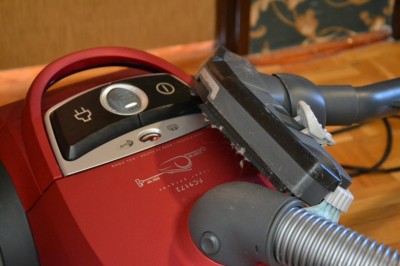What Makes Cat Dander a Problem?
Cat dander is a carrier mechanism for cat allergens, which is bad enough. But there are several additional aspects to be considered. First, even one cat produces enough dander to be a plentiful food source for dust mites. Dust mites serve as a secondary source of allergens through their droppings and their dead, dried up carcasses. Not only should the impact of cat allergens and dander be considered, but also the effects of increased dust mites. If youve ever noticed dust in a shaft of sunlight the particles you were seeing were typically in the 50-micron size. Under ideal conditions the unaided human eye might be able to see particles as small as 10 microns. Approximately 75% of cat dander particles are 5 to 10 microns and 25% are 2.5 microns or smaller. Particles that size do not readily settle out of the air. They are also easily disturbed and become airborne. Cat Dander and House Cleaning are Dangerous This is a real problem when doing house cleaning or when actively seeking to remove dander. Studies show that vacuum cleaners easily aerosolize cat allergen on floors and carpets to critical levels. In clinical studies of asthma, a nebulizer may be used to provoke an asthmatic response of a 20% Fall in Expiratory Volume (FEV). The quantity of allergen aerosolized would be on the order of 40 nanograms per cubic meter of air. Studies have shown that cleaning and vacuuming produced this same level of contaminant per volume of air. For asthmatic persons, exposures to cat allergen during household cleaning could result in a trip to the emergency room, or the morgue, depending on their control of their asthma. It is recommended that any household with a cat use a high quality HEPA vacuum. Effectiveness in controlling cat allergen can vary widely depending on the HEPA vacuum. The best HEPA vacuums keep airborne allergen to a bare minimum. Cat Dander Damages Lungs The size of cat dander particles puts them in the category of lung penetrating particles, particles that easily transport to the innermost recesses of the lungs. Since they are not just particulate irritants but immunological irritants, they can do significant cumulative damage. Chest X-rays of allergic individuals have found that long-term exposure to cat dander results in nodules forming inside the lungs. Reduced lung function and permanent lung damage result from this kind of long-term exposure to an allergenic lung-penetrating particle. This should be of special concern to parents of cat allergic children, because childrens lungs are still growing and are even more sensitive to airborne contaminants. Children also consume larger volumes of air per body weight than do adults, so contaminants have a more pronounced effect on children due to the higher concentrations that accumulate in their bodies. The particle size of cat dander also presents a challenge because at that size range particles tend to stick to surfaces by molecular adhesion. Molecular adhesion renders particles especially sticky. For this reason, once a surface or clothing is contaminated with cat allergen it tends to stay contaminated until vigorous cleaning has been performed. More than light dusting is required; scrubbing and using chemical cleaners is the best way to remove them. The stickiness of cat allergen has resulted in cat allergen being found in homes, schools, offices, and government buildings where cats have never been. Riding in on the clothes of cat owners, cat allergen constitutes an all-pervasive background that may be sufficient to cause allergic reactions. What is the Best Air Purifier for Cat Dander? A HEPA filter air purifier is the best choice for reducing airborne dander. HEPAs 99.97% filtration at 0.3 micron makes them the perfect air purifiers for pet dander. The possibility of increased adhesion to lung tissues of lung penetrating particles that have been negatively charged should dissuade the consumer from purchasing a negative air ionizer air cleaner. Ionic air cleaners that generate ozone and ozone generators should be avoided. Ozone causes increased sensitivity to allergens and makes airborne cat allergen all the more potent to the unwary consumer. Ozone will not clean particles from the air. Electrostatic precipitators are about 80% efficient with clean, unloaded plates. Efficiency can drop to below 20% in as few as three days due to plate loading, thus requiring constant maintenance cleaning. An allergic person should not perform this maintenance cleaning. Concentrated allergens could provoke a severe reaction if inhaled while trying to clean the plates. Cat allergen can also cause skin rashes in allergic persons who come in physical contact with it. The only air purifier to remove pet dander safely and effectively is a HEPA filter air purifier. If you would like to know more about the best air purifiers for pet dander then please allow me to share with you the top ten purifiers featured on my site. From J Alan Rodgers - The Air Purifier Expert at http://www.Home-Air-Purifier-Guide.com























